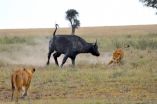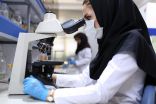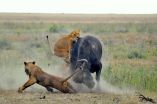(Press-News.org) WASHINGTON, DC (September 3, 2015)-- The District of Columbia's needle exchange program prevented 120 new cases of HIV infection and saved an estimated $44 million over just a two-year period, according to a first-of-a-kind study published today by researchers at the Milken Institute School of Public Health (Milken Institute SPH) at the George Washington University.
"Our study adds to the evidence that needle exchange programs not only work but are cost-effective investments in the battle against HIV," says Monica S. Ruiz, PhD, MPH, an assistant research professor in the Department of Prevention and Community Health at Milken Institute SPH. "We saw a 70 percent drop in newly diagnosed HIV cases in just two years. At the same time, this program saved the District millions of dollars that would have been spent for treatment had those 120 persons been infected."
The new study, published in the scientific journal, AIDS and Behavior, may help to inform the ongoing debate among policymakers about whether to provide funding for programs that distribute sterile injection equipment to drug users. Last spring, health officials in Indiana's Scott County created a needle exchange program to deal with injection drug use and the rapid spread of HIV--and local officials in other parts of the U.S. are considering the same move. Critics argue that such programs encourage illicit drug use. But other research has shown that drug users who come in for clean needles often get other health services-including referral to programs that treat drug addiction.
In 1998, Congress banned the use of federal funds for needle exchange programs but did allow states and cities to use locally generated revenues to establish such exchanges--and many cities did just that. However, the ban continued to affect the District of Columbia, making it the only city in the nation which could not use municipal funds to start such a program. Finally, in December 2007, legislation was passed that lifted the so-called DC ban and the city's Department of Health moved swiftly to start a program that included needle exchange and referrals to HIV testing and addiction treatment programs.
Ruiz and her colleagues examined how this change in policy affected the HIV epidemic in terms of actual new cases associated with injection drug use. The research team used surveillance data to determine the actual number of new injection drug use (IDU)-related cases of HIV following the removal of the DC ban and the implementation of the needle exchange network. Next, the team used a modeling technique to forecast how many cases of HIV would have occurred had the DC ban remained in place.
They found that, if the DC ban had remained in place, an estimated 296 injection drug users would have gotten HIV during the two-year study period. In fact, once the ban was removed and the District launched its needle exchange network, only 176 new cases of IDU-associated HIV occurred. "The lifting of the DC ban prevented about 120 injection drug users from becoming infected in just two years," Ruiz says. "Furthermore, the DC needle exchange program continues to reduce the number of new cases of HIV among injection drug users in the city."
Needle exchange programs help the most disadvantaged and vulnerable people, including drug users and people who exchange sex for drugs, says Ruiz, adding that the program is a potent weapon in the war against AIDS. Despite recent progress against HIV, the District of Columbia still has one of the worst epidemics of HIV in the nation, according to the U.S. Centers for Disease Control and Prevention.
Past research has looked at how well needle exchange programs work: For example, a Washington state study found that a needle exchange program led to more than an 80 percent reduction in the new cases of hepatitis B and C infections--both blood-borne diseases that also can be passed on through the use of dirty needles. And a New York program demonstrated that giving drug users clean needles resulted in a 70 percent drop in new HIV infections.
However, the study by Ruiz and colleagues also looked at the cost savings associated with this policy change event in DC. Ruiz and her colleagues took estimates from the U.S. Centers for Disease Control and Prevention on the average lifetime cost of treating HIV and calculated that averting 120 cases of HIV infection would lead to a savings of about $44.3 million.
Many injection drug users are covered by publicly funded health plans. If HIV transmission is prevented, savings would accrue as a result of not having to treat HIV infection over the course of the person's life. "Thus, it could be reasoned that the $44.3 million in savings is money that is saved by taxpayers," Ruiz says.
Such needle exchange programs are relatively inexpensive to operate. For example, the District allocated just $650,000 per year for the first 24 months of the program and it provides more than just access to clean needles. Drug users can also get an HIV test, free condoms--which also prevent sexually transmitted diseases--and it is often the only connection that drug users have to a regular source of health care, including tests that can spot an emerging problem like hepatitis.
INFORMATION:
Ruiz and her colleagues published the study, "Impact Evaluation of a Policy Intervention for HIV Prevention in Washington, DC," online in the journal AIDS and Behavior.
About Milken Institute School of Public Health at the George Washington University: Established in July 1997 as the School of Public Health and Health Services, Milken Institute School of Public Health is the only school of public health in the nation's capital. Today, more than 1,700 students from almost every U.S. state and 39 countries pursue undergraduate, graduate and doctoral-level degrees in public health. The school also offers an online Master of Public Health, MPH@GW, and an online Executive Master of Health Administration, MHA@GW, which allow students to pursue their degree from anywhere in the world.
Why are there not more lions when there's plenty of prey on the African savanna?
A research team including two University of Guelph ecologists has discovered an unexpected pattern linking prey and predator species in diverse ecosystems worldwide.
Integrative biology professors John Fryxell and Kevin McCann co-authored the paper, published today in Science. The team included researchers at McGill University, the University of British Columbia and the Perimeter Institute for Theoretical Physics in Waterloo, Ont.
Beyond lions and the gazelles they hunt on the African ...
This news release is available in Japanese.
Regular exposure to bacteria particles and farm dust protects children from allergies because it blunts their inflammatory immune responses, a new mouse study suggests. The study implicates a particular anti-inflammatory enzyme, A20, in this protective effect. While aspects of how allergies develop remain unclear, scientists know they're driven not only by genes but also by environment. Homes with pets, as well as dairy farms - where children breathe dust containing higher doses of fungal particles, cowshed-derived bacteria ...
This news release is available in Japanese.
Ecological communities around the world are richly varied, but a new study finds that many of these diverse communities follow an unexpected, yet consistent pattern: where prey are abundant, there are not proportionally more predators. Instead, as prey biomass increases, the ratio of predator-to-prey biomass decreases. This pattern was systematically identified across different areas, including grasslands, forests, lakes, and oceans, revealing an underlying structural organization of ecosystems. Pinpointing underlying ...
This news release is available in Japanese.
Researchers have identified a mutation in plants that allows them to break down TNT, an explosive that has become highly prevalent in soil in the last century, particularly at manufacturing waste sites, mines, and military conflict zones. TNT, or 2,4,6-trinitrotoluene, is a toxic and persistent environmental pollutant that accumulates in the roots of plants, inhibiting growth and development. The identification of a plant mechanism that not only evades the negative impacts of TNT, but breaks down this harmful substance could ...
This news release is available in Japanese.
A special news edition, Science in Iran, looks closely at the scientific challenges and triumphs of a country that has faced international isolation in recent years. Following an exclusive interview about the Iran nuclear deal with Ali Akbar Salehi, president of the Atomic Energy Organization of Iran, Science International News Editor Richard Stone delves further into the state of Iran's scientific endeavors. Decades of economic sanctions have deprived Iranian scientists of critical scientific resources and collaboration. ...
Biologists at the University of York have taken an important step in making it possible to clean millions of hectares of land contaminated by explosives.
A team from the Centre for Novel Agricultural Products (CNAP) in the University's Department of Biology has unravelled the mechanism of TNT toxicity in plants raising the possibility of a new approach to explosives remediation technology. TNT has become an extensive global pollutant over the last 100 years and there are mounting concerns over its toxicity to biological systems.
The study, which is published in Science, ...
Researchers at VIB (a leading life sciences institute in Flanders, Belgium) and Ghent University have successfully established a causal relationship between exposure to so-called farm dust and protection against asthma and allergies. This breakthrough discovery is a major step forward towards the development of an asthma vaccine. The results of the research were published in the leading journal Science.
It is commonly known that drinking raw cow's milk can provide protection against allergies. A 14-member research team, led by professors Bart Lambrecht and Hamida Hammad ...
Evidence from a new study published in PLOS Computational Biology by researchers from Brown University and led by Assistant Professor Thomas Serre suggests that when we analyze scenery we simply make the easiest judgments first, rather than following a priority order of categories.
There are many ways we understand scenery. Is it navigable or obstructed? Natural or man-made? A face or not a face? In previous experiments, researchers have found that some categorization tasks seem special, in that they occur earlier than others, leading to a hypothesis that the brain has ...
Rodents huddle together when it is cold, they separate when it is warm, and at moderate temperatures they cycle between the warm center and the cold edges of the group. In a new study published in PLOS Computational Biology, Jonathan Glancy, Roderich Gross, Jim Stone and Stuart Wilson from the University of Sheffield found they could simulate huddling by assuming simply that touching individuals in turn brings their temperatures closer to an ideal body temperature. According to the model, these selfish individual behaviours improved the ability of the whole group to regulate ...
Why aren't there more lions? That was what puzzled McGill PhD student Ian Hatton, when he started looking at the proportion of predators to prey across dozens of parks in East and Southern Africa. In this case, the answer had nothing to do with isolated human hunters. The parks were teeming with potentially tasty treats for the lions. So one might imagine that the population of lions in each park would increase to match the available prey. Instead, what Hatton and the McGill-led team discovered was that, in a very systematic way, in crowded settings, prey reproduced less ...



